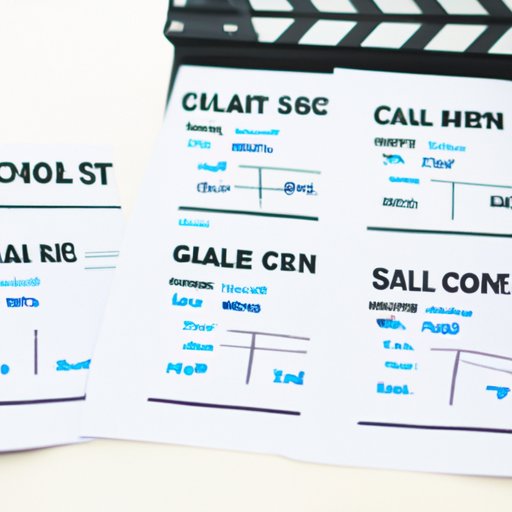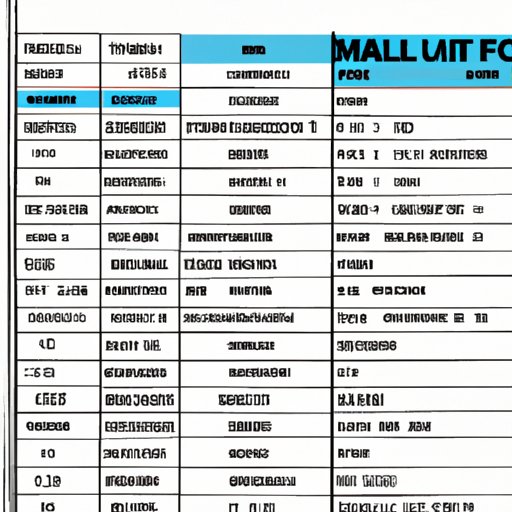Introduction
If you’ve ever been involved in a film production, then you’ve likely heard the term “call sheet.” But what exactly is a call sheet? In short, a call sheet is a document used to organize and plan a shoot day. It outlines all the details about the shoot, including the cast and crew information, locations, times, and other important details.
In this article, we’ll take a look at what a call sheet is, how to create one, its benefits, and examples of call sheets in action on set. So let’s dive in!
What is a Call Sheet in Film Making?
At its core, a call sheet is a document that contains all the information needed for a successful shoot day. It includes details such as the location, time, cast and crew information, scenes to be shot, and more.
The call sheet is usually created by the Production Manager and distributed to the cast and crew prior to the shoot day. It’s an essential tool for any film production and should be included in your pre-production and on-set plans.
Breaking Down the Components of a Call Sheet
A typical call sheet will contain the following components:
- Scene Information: This section includes the scene numbers, descriptions, and page counts.
- Locations: This section includes the address and contact information for each location.
- Call Times: This section includes the call times for the cast and crew.
- Cast & Crew: This section includes the names and contact information for everyone involved in the production.
- Equipment: This section includes the equipment needed for the shoot.
- Special Notes: This section includes any special notes or instructions.
How to Create an Effective Call Sheet
Creating an effective call sheet can help you stay organized and on track during a shoot. Here are some tips for creating an effective call sheet:
- Be clear and concise: Your call sheet should include only the most relevant information. Don’t include too much detail that could be confusing or overwhelming.
- Double check: Make sure to double check your call sheet for accuracy before sending it out. This will ensure that everyone has the correct information.
- Include contact information: Include contact information for everyone involved in the production, including the cast and crew.
- Keep it organized: Keep your call sheet organized so that it’s easy to read and understand.
Benefits of Using a Call Sheet in Film Production
Using a call sheet has many benefits for a film production, including the following:
- It helps keep everyone on the same page. The call sheet ensures that everyone involved in the production has the same information.
- It helps save time. By having all the necessary information in one place, it allows the production to run more smoothly and efficiently.
- It helps avoid confusion. Having a call sheet helps to avoid confusion and miscommunication between the cast and crew.
- It helps keep the production on track. By having a call sheet, it helps the production stay on track and meet its deadlines.
Understanding the Different Types of Call Sheets and When to Use Them
There are several different types of call sheets, including daily call sheets, weekly call sheets, and pre-production call sheets. Each type of call sheet has its own purpose and when it should be used:
- Daily Call Sheets: These are used on the day of the shoot and contain all the necessary information for the day. They are typically distributed the night before the shoot.
- Weekly Call Sheets: These are used for longer shoots and contain all the information for the entire week. They are typically distributed at the beginning of the week.
- Pre-Production Call Sheets: These are used to plan the shoot in advance and contain all the necessary information. They are typically distributed prior to the start of the shoot.
Tips for Optimizing Your Call Sheet
Here are some tips for optimizing your call sheet:
- Make it easy to read: Keep your call sheet organized and easy to read.
- Include all the necessary information: Make sure to include all the necessary information in your call sheet.
- Keep it up to date: Make sure to update your call sheet regularly as changes occur.
- Include contact information: Always include contact information for everyone involved in the production.

Examples of Call Sheets in Action on Set
Now that we’ve discussed what a call sheet is and how to create one, let’s take a look at some examples of call sheets in action on set.
Sample Call Sheets from Popular Films
Here are some sample call sheets from popular films:
Best Practices for Using a Call Sheet on Set
Here are some best practices for using a call sheet on set:
- Distribute the call sheet ahead of time: Make sure to distribute the call sheet to the cast and crew ahead of time so they have plenty of time to prepare.
- Check in with the cast and crew: Check in with the cast and crew throughout the day to make sure everyone is on the same page.
- Update the call sheet as needed: If changes occur during the shoot, make sure to update the call sheet accordingly.
- Be flexible: Be prepared to change things up if needed. Things don’t always go as planned, so be prepared to adjust.
Conclusion
A call sheet is an essential tool for any film production. It’s a document that contains all the information needed for a successful shoot day, including the locations, times, cast and crew information, and more. Creating an effective call sheet can help you stay organized and on track during a shoot. There are several different types of call sheets, each of which has its own purpose and when it should be used. Finally, there are several best practices for using a call sheet on set, such as distributing it ahead of time and updating it as needed.
In conclusion, using a call sheet is a great way to stay organized and efficient during a film production.
(Note: Is this article not meeting your expectations? Do you have knowledge or insights to share? Unlock new opportunities and expand your reach by joining our authors team. Click Registration to join us and share your expertise with our readers.)
